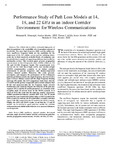| dc.contributor.author | Elmezughi, M. | |
| dc.contributor.author | Oyie, Nicholas O. | |
| dc.date.accessioned | 2021-04-21T12:06:17Z | |
| dc.date.available | 2021-04-21T12:06:17Z | |
| dc.date.issued | 2021-03 | |
| dc.identifier.citation | SAIEE Africa Research Journal, vol.112 n.1 Observatory, Johannesburg Mar. 2021 | en_US |
| dc.identifier.issn | 1991-1696 | |
| dc.identifier.uri | https://ieeexplore.ieee.org/stamp/stamp.jsp?arnumber=9340535&tag=1 | |
| dc.identifier.uri | http://www.scielo.org.za/scielo.php?script=sci_arttext&pid=S1991-16962021000100004 | |
| dc.identifier.uri | http://hdl.handle.net/123456789/4595 | |
| dc.description.abstract | The critical rule to achieve extremely high peaks of data transmission is the availability of a tremendous amount of bandwidth. The super high frequency (SHF) and the millimeter-wave (mmWave) frequency bands are the candidates for the deployment of the 5C cellular system and for satisfying future needs due to their massively available blocks of contiguous raw bandwidth that is capable of supporting additional data traffic for multimedia services. This research paper presents propagation measurements at three frequencies above 6 GHz, which are 14, 18, and 22 GHz frequency bands. The measurements were carried out for both line-of-sight (LOS) and non-line-of-sight (NLOS) communication scenarios in an indoor corridor environment to present frequency- and distance-dependent wireless channel models. Moreover, this study presents, investigates, and compares the performance of two well-known path loss prediction models; the single frequency close-in (CI) free space reference distance model and the single frequency floating intercept (FI) model. The LOS comparison study shows that the CI and FI models provide comparable and accurate estimates that fit the real measured data for the frequency bands selected. Furthermore, the study investigates the behavior of the path loss exponent (PLE) and the FI model parameters as a function of the reception angle of arrival (AoA) in the NLOS scenario. It is observed from this work that the path loss models' parameters exhibit symmetrical behavior around 180° AoA. The FI model provides the same standard deviation values as the CI model in the LOS scenario. In contrast, the FI model offers a notable reduction (up to 2.84 dB) compared to the CI model in the NLOS scenario.
Finally, the LOS and NLOS results reveal that the CI and FI models can be trusted as good path loss models for corridor environments and exhibit stable behavior over measured distances and frequencies. | en_US |
| dc.language.iso | en | en_US |
| dc.subject | SHF, mmWave, channel sounder, directional antennas, angle of arrival, indoor corridor environment, path loss models, propagation measurements, 14 GHz, 18 GHz, 22 GHz. | en_US |
| dc.title | Performance Study of Path Loss Models at 14, 18, and 22 GHz in an Indoor Corridor Environment for Wireless Communications | en_US |
| dc.type | Article | en_US |

